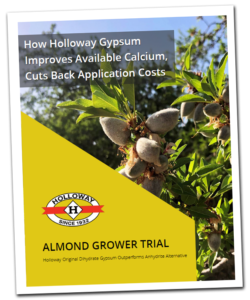By Allie Cushnyr
Senior Agronomist, Holloway
Mother Nature has her own schedule that each of us live by every day. Based on weather forecasts, we decide whether to go on a morning run, seed rye on the lawn and if we want to host a backyard BBQ. Farming feels the same effects. The climate decides what plants will thrive in the field, the diseases we fight against for top yields, and whether rain will temporarily halt harvest. This first big rain of the season was poorly timed for some harvesting activity, field preparation, and planting fields before winter arrives, but let’s flip the script and look at the positives and how to best take advantage of this opportunity.
Many of the fields I work with struggle with salt accumulation within the soil. These salts come from various sources including the parent material of the soil, the water we use to irrigate our fields with fertilizers, and potentially areas with high water tables. Wintertime is commonly a period of leaching salts out of the root zone by applying clean water to the field. We tend to see well water with the highest salt accumulation, followed by surface water. The best source of water is right from Mother Nature herself, when it falls from above. California’s southern valley sees significantly less rainfall than the northern regions, so their opportunity to use rain for leaching goes down. Water is the first step to leaching salt accumulation, but utilizing true dihydrate gypsum (CaSO4+2H2O) is a great way to take advantage of winter rain.

Dihydrate gypsum is the most soluble form of calcium sulfate in industry, so when an application is paired with either a rainstorm or irrigation event, we can begin to incorporate it into the soil profile. The importance of true gypsum to soil, with high sodium, is key because the calcium can take the place of sodium on the soil’s exchange capacity. This switch then frees up more sodium to be leached below the root zone. This process will take multiple rain events or irrigations; one long irrigation is not as effective because it doesn’t give the gypsum time for its full potential.
Did you miss the first rainfall to get gypsum on the field? No problem. You used great opportunity to add moisture into the soil profile ahead of a gypsum application. Just be ready with your gypsum for a future rain event. Another option is to run irrigation to incorporate into the soil profile which is best achieved with flood irrigation, followed by micro sprinklers and drip emitters. The drip emitters don’t work as well because the wetted zone is less than the area where the gypsum was spread. This is why a rain event works best. Again, we are working with nature, so nothing is perfect, and we just do the best that we can.
Contact us today to get your soils tested and amendment and service orders on the books to beat the next rainstorms and optimize your soils for coming seasons.
Join Over 800 Companies Using Holloway Today.
Or Become Part of The Holloway Group to Further Your Career.

